January 9, 2017 – Volume 19 #1: The End of Cars
In This Issue
Flanigan’s Eco-Logic
CARR-e, Conveyance and Last Mile
CA’s Cap-and-Trade: An Update
ZNE California
LA’s Ever-Green Transportation Measure
The Santa Rosa Story
Wind Updates
Tesla’s Solar Rooftop
Bowl-Shaped Roofs from Iran

Flanigan’s Eco-Logic: The End of Cars
An article in the New York Times this past week suggested that the car might follow the plight of the horse and buggy. That’s a bold assertion and big step. Especially when you look at record car sales:
In 2015, there were a record 17.5 million sold in the United States, with projections of nearly 18 million cars and trucks sold in 2016. Low gas prices have “reignited the market” for higher-priced SUV and pickup sales. Globally, 72.4 million cars and trucks sold in 2015 with a projection of 75.2 million in 2016. Of these, 33 million were sold in Asia compared to 21 for North America, and 13.7 in Western Europe.
And EVs are on the rise. This week, Tesla’s Nevada “Gigafactory” opened. Its ultimate capacity will produce batteries for 1.5 million EVs per year. That’s a train that has left the station! And now Israeli inventors are working on “next-gen” EV roadways that will wirelessly energize EVs as they ply these special highways.
Back to the horse and buggy analogy. We’re living in really exciting times; very far-out concepts are quickly being realized as trends. There are new economies, shaped by the Internet, social media, startups, and apps… including those for mobility such as “ride-hailing services.”
Can you imagine wiping out the second largest annual consumer cost? For most Americans, the first cost is housing. The second largest cost is the car. The average car sales price of $34,500 just gives you the keys. Like horses of yesteryear, we massage cars, we barn them, feed them, and wash them… paying large sums for mobility.
The Times points to several factors that are transforming mobility: First is the urbanization of our culture; cities are growing and the need to own cars is declining. Congested freeways are a bummer. Second, driverless pool vehicles are the rage. There are numerous transport-on-demand services like Uber whose pools can supplant individual car ownership. Third, very bright minds are working on new forms of mobility – such as CARR-e — to move us from mass transit station to our home or flat… the infamous last mile.
So the end of cars? Not yet. Demand and sales are more robust than ever. But the times they are a’changing… and designers are hard at work for better forms of mobility. Their visions are nothing short of exciting.
Quote of the Week
“The future is going to overwhelmingly be solar plus battery. They go together like peanut butter and jelly.”
– Elon Musk quoted by Bloomberg New Energy Finance
CARR-e, Conveyance and The Last Mile

Ford’s Carr-E
Responding to megatrends in mobility, automakers have to be strategic. In some cases, motor companies are getting back to basics: Ford is sponsoring a bicycle-sharing program in San Francisco. Its goal is to have 7,000 Ford-branded bikes there by 2018.
Then there is the high-tech angle: Ford is developing “motorized conveyance devices” to address the “last mile” to get from transit to home or work. One of these, the Carr-e, puts a new spin on transport. It looks like a giant white hockey puck that a passenger stands on en route to his or her destination.
CARR-e is a result of a Ford Motor Company design challenge called the Global Mobility Challenge. The internal competition resulted in 633 means for “the last mile” mobility. Three finalists were selected, including the CARR-e design developed by a Ford Systems Engineer in Cologne, Germany.
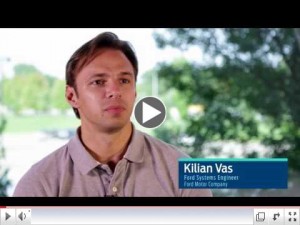 The CARR-e designer Kilian Vas designed his conveyance device to be about the size of a car tire. Prototypes are 25 pound, four-wheeled, hoverboard-like devices that can fit in spare tire compartment in a car and that can be easily taken out to cover the last mile. One charge can provide 14 miles of mobility at 11 miles per hour. And, if you do not want to carry your luggage, using wireless sensors, CARR-e can carry your bags and while keeping a prescribed distance of up to nine meters.
The CARR-e designer Kilian Vas designed his conveyance device to be about the size of a car tire. Prototypes are 25 pound, four-wheeled, hoverboard-like devices that can fit in spare tire compartment in a car and that can be easily taken out to cover the last mile. One charge can provide 14 miles of mobility at 11 miles per hour. And, if you do not want to carry your luggage, using wireless sensors, CARR-e can carry your bags and while keeping a prescribed distance of up to nine meters.
Ford’s challenge underscores gross creativity in mobility. The other two finalists were TriCiti, a folding tricycle that can serve as vehicle, shopping cart, stack trolley, or golf buggy; and eChair, an electric wheelchair that can load itself into an auto.
California’s Cap-and-Trade: An Update
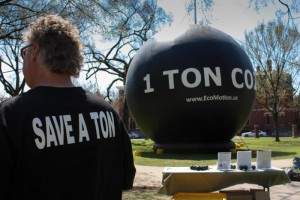 The European Union’s Emissions Trading Scheme was the first cap-and-trade program. It was designed to help its 27 member states meet their Kyoto Protocol commitments. These programs place a cap on emissions – which declines each year – and allows major emitters to buy and sell emissions credits to most cost-effectively meet the cap.
The European Union’s Emissions Trading Scheme was the first cap-and-trade program. It was designed to help its 27 member states meet their Kyoto Protocol commitments. These programs place a cap on emissions – which declines each year – and allows major emitters to buy and sell emissions credits to most cost-effectively meet the cap.
California’s Cap and Trade program was launched in 2012 with quarterly auctions. Then in 2014, California and Quebec officially linked their programs and there have been nine joint auctions since then. Cap-and-Trade is a key element of California’s plan to meet its aggressive greenhouse gas reduction requirements. The California Air Resources Board’s Scoping Study presented details on how the State will fulfill the requirements of the 2006 Global Warming Solutions Act.
To many, California’s Cap-and-Trade program is failing, “stumbling badly and facing an increasingly hazy future.” The program features quarterly auctions. In May 2016, only 2% of the auction’s eligible credits were sold, resulting in just $10 million for State programs, and of this, only $2.5 million for California’s notorious high-speed rail program. Projected revenues from this auction for high-speed rail had been $150 million.
Of the 96 million credits that went on sale for this most recent auction, only 30.8 million credits were sold. And of the total auction revenue of $390 million, only $8.4 million is available to support State programs. The rest of the auction revenues are directed to utilities to help buffer customers from the costs of paying for reducing carbon emissions.
At its launch there were great fears that the costs of credits would go sky high, resulting in bankrupt industries and other manufacturers in the State. But no, there are excess credits and insufficient demand for even CARB’s minimum price of $12.73 per ton of carbon emissions.
California’s program is not unique: Experts report that there is a glut of emissions credits in cap-and-trade programs around the world. And because of this, cap-and-trade is largely being seen as failure. The Governor, the legislature, and others had hoped to split up a very large pot of money to fund green initiatives. So is Cap-and-Trade failing in the Golden State?
Some experts say that while cap-and-trade’s revenues are not what were expected, more fundamentally, California is on track with its greenhouse gas reductions. This is good news… the most important and basic metric of all. There are at least two reasons for this success: First, much industry is gone and what’s left has not fully recovered from the recession. Second, another regulatory mechanism, the Renewable Portfolio Standard, is requiring utilities to cut carbon emissions, thereby reducing their need for allowances.
The result of the current state of cap-and-trade in California is that there is a lack of support to extend the program beyond 2020. Governor Jerry Brown wants to extend it to support the SB 32 goal of achieving a 40% GHG reduction from 1990 levels by 2030. But he got little support for this logic and SB 32 was silent on cap-and-trade. Potentially, the Governor will take cap-and-trade to the voters in the form of a referendum to keep it alive in California.
ZNE California

Source: ABC Homes
ZNE is all the rage, just as LEED was ten years ago! Zero Net Energy (ZNE) is a “big and bold” initiative. All new California homes must be ZNE by 2020; the same is true for all new California commercial buildings by 2030. These are lofty goals set by CPUC in 2007 and codified as State policy in the California Long-Term Energy Efficiency Strategic Plan adopted in 2008. Since buildings are the second largest source of greenhouse gases, these big and bold initiatives are well targeted.
There are many ways to consider a building’s footprint, and the offset of that footprint. First, what about natural gas and propane use? (California does include these in its ZNE equation.) What about embodied energy in building materials? (California does not include that!) And what about transportation energy? Must a ZNE building also offset its power for EVs? (California does not require that.) And where is the renewable generation located? Is it on site? Or is it at the source, for instance a wind farm or community solar array? In California, at least so far, ZNE generation must be on site.
By definition, ZNE buildings must produce as much as energy as they consume over the course of a year. That’s the simple definition. Today, the State of California defines ZNE when, “The societal value of energy consumed by the building over the course of a typical year is less than or equal to the societal value of the on-site renewable energy generated.”
Let’s add a bit more detail, “A ZNE building is one where the value of the energy produced by on-site renewable energy resources is equal to the value of the energy consumed annually by the building measured using the California Energy Commission’s Time Dependent Valuation (TDV) metric.”
Under TDV, energy is valued on an hourly basis that better reflects the actual cost of energy to the customers, to the utility system and to society. TDV multipliers vary for each hour of the year and by energy type, Climate Zone and by building type.
TDV values are calculated separately for the three primary fuels used in buildings – electricity, natural gas and propane. Critics cringe at the use of TDV, noting that a ZNE building can have as little as 60% of its consumption supplied by renewables.
Energy efficiency measures will also be subject to, and potentially benefit from, TDV. The TDV method encourages building designers to design buildings that perform better during periods of high-energy costs… versus offsetting 100% of their consumption. Critics of this methodology note that ZNE homes per 2016 Title 24 part 6, and building on the State’s net energy metering, are really “zero net bill” homes.
Unquestionably, efficiency is key to ZNE, and climate can help: Zero net energy is easiest to achieve in mild coastal areas with light heating and cooling loads such as Santa Monica which passed a ground-breaking, voluntary ZNE reach code in 2016.
Los Angeles’ Ever-Green Transportation Measure
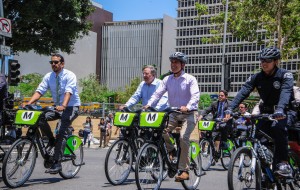
Mayor Garcetti at the launch of Metro Bike Share
The citizens of Los Angeles made a strong statement on Election Day: They voted in force. Fully 71.2% of those who voted approved Ballot Measure M. The most ambitious transit expansion in Los Angeles County history, Measure M will generate $120 billion over four decades. It will fund construction of a dozen new rail lines and connections to Pacoima, Claremont, Artesia, and Torrance. The measure needed a two-thirds majority vote to pass and got 71.2% at the end of the day!
The measure is known as “ever-green” because it calls for a permanent tax increase. The current county-wide half cent sales tax will increase to one cent when current half cent Measure R expires in 2039. The measure is projected to reap $860 million annually for decades. It will build a rail line to LAX, a double-tunnel subway under Sepulveda Pass, and will construct the Purple Line extension to Westwood.
Measure M also allows for sidewalk improvements, pothole repairs, cycling infrastructure, bike share expansion, and a network of greenways. Fully 8% of the funds will go to “active transportation” — walking and biking — compared to 1% in the current Measure R funding. The measure will also fund 10 highway projects, including several new tolled carpool lanes, and a carpool interchange between 405 and 110 freeways. Phil Washington, Metro’s popular General Manager, says he hopes to convert 20 – 25% of the County’s population into regular transit riders, more than three times the current rate.
The Santa Rosa Story
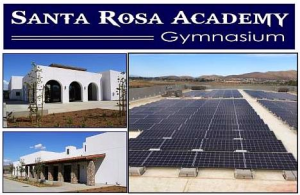 In July of 2015, EcoMotion received a call from the Santa Rosa Academy (SRA), a charter school in Menifee, California that features varying levels of home schooling for its students and their families. SRA’s principal, Laura Badillo, was a bit puzzled. She’d heard of a Prop 39 for school facilities, but is there another Prop 39 she asked? Her son works at the California Center for Sustainable Energy and recommended she call EcoMotion.
In July of 2015, EcoMotion received a call from the Santa Rosa Academy (SRA), a charter school in Menifee, California that features varying levels of home schooling for its students and their families. SRA’s principal, Laura Badillo, was a bit puzzled. She’d heard of a Prop 39 for school facilities, but is there another Prop 39 she asked? Her son works at the California Center for Sustainable Energy and recommended she call EcoMotion.
Yes, there is another Prop 39 for school energy efficiency, the California Clean Energy Jobs Act. It turned out that SRA was entitled to about a half million in funding over the five-year Prop 39 funding cycle. Not surprisingly, Laura was pleased to hear it and to take steps to use the funds. So we visited SRA’s campus two hours southeast of LA.
SRA’s campus is clean, fresh and brand new. They’ve been on this campus for just two years. It’s blooming with native landscaping accenting student common areas. The campus buildings feature Spanish-style architecture with red clay roof tiles and white stucco walls. Its facilities were all built to California’s rigorous Title 24 building standards. Upon first blush, it appeared that there was little to be done to make this charter school more efficient.
Laura is most gracious: She’s a rock star and at the helm of this ship. The school is gorgeous and thriving. Everyone is pleasant and energized. It’s a pleasure to be on campus. We explained the Prop 39 program and show her SRA’s allocation schedule. We talked options for use of the funds, from weather-sealing doors to better controlling air conditioning units to advanced energy storage. Yes, the school has had a keen interest in solar she stated. This led to a full-blown investigation.
EcoMotion went on rooftops but they were tiled or too small to support a significant array. We explored parking lots but newly planted trees dampened interest in solar there. With SRA officials, we looked at other areas for ground-mounted solar, and even contemplated a creative design involving construction of a solar canopy above the running track. Ultimately we decided to put solar on the new gym in construction.
Fast forward to the date just a few weeks ago when SRA christened and energized the 86.3 kW photovoltaic array… installed at no cost to the school. After a competitive bidding process managed by EcoMotion, Skelly Electric was selected for the $362,770 installation. The school also got an extra and special roof coating to handle the system. And beyond being able to boast about its solar system, first-year bill savings are projected to be $47,700, with ~ $1.8 million in savings over 20 years thanks to the value of solar generation when coupled with a rate switch to a “solar friendly” tariff known in Southern California Edison as Option R.
And there’s still money left over! Thus EcoMotion is now putting in a wireless control system for the school’s HVAC units, putting in 73 smart thermostats, and timers for exterior lights and bathroom fans that had been running 24/7. SRA is also able to subscribe to an energy dashboard service to monitor and evaluate energy consumption and utility costs, making its green energy works clear and exciting for its students and the entire school community.
All told, SRA is a very happy client and now our team is replicating the model at nearby Sycamore Academy. At first unsure of it’s Prop 39 opportunity, Santa Rosa Academy is now able to boast green electrons on campus, and to be able to educate its 1,500 students about renewable power and how the SRA school community is making a significant and measurable difference in crafting a global, sustainable future.
EcoMotion is pleased to serve a number of school districts and charter schools in California – nearly 130 campuses — with energy management services. We’re also pleased to announce that in December, EcoMotion was retained by the City of Santa Monica to manage the Solar Santa Monica program, extending the ten years of service that we have supported the City with its award-winning solar program.
Wind Updates
 First U.S. Offshore Wind Farm: If you’re a fan of offshore wind, uncork the champagne! December, 2016 marked the christening – the final interconnection – of the first offshore wind installation in the United States. The Deepwater Wind Farm – six, 5 MW turbines — was energized off Block Island on Monday, December 13th. Wind will now power 90% of Block Island’s power needs, a resort community formerly dependent upon diesel generators.
First U.S. Offshore Wind Farm: If you’re a fan of offshore wind, uncork the champagne! December, 2016 marked the christening – the final interconnection – of the first offshore wind installation in the United States. The Deepwater Wind Farm – six, 5 MW turbines — was energized off Block Island on Monday, December 13th. Wind will now power 90% of Block Island’s power needs, a resort community formerly dependent upon diesel generators.
U.S. Offshore Wind Potential: Block Island is likely the tip of the iceberg. Offshore wind in the United States has huge potential. A 2013 technical report issued by the National Renewable Energy Laboratory found that the wind potential off the United States coast to be 4,223 GW, nearly four times the current generating capacity of all power plants in the country. The barriers to offshore wind developments are largely non-technical. They are not construction related. Instead they include complicated rules about who gets to build and disrupt the sea floor. They include legal battles between the impacts to ocean views and those that advocate a clean energy future. Earlier in 2016, the Obama Administration approved the offer of a 79,000-acre offshore lease off the coast of Long Island, 12 miles southeast of Jones Beach State Park.
European Offshore Wind: Yes, the United States is getting a slow start with offshore wind. The first offshore wind farm in the world was built in 1992 off the Danish coast. This past year alone, Europe installed about 100 times the Block Island capacity, ~3,000 MW of offshore wind power. Note that President-elect Donald Trump unsuccessfully fought an offshore wind farm off Scotland near one of his golf courses.
U.S. Terrestrial Wind Farms: Back on shore, the United States has been developing wind big time! At the end of 2015, the U.S. had 73,992 MW generating enough power to serve 20 million Americans. At that time there were 48,800 wind turbines in the country; fully 40 states have utility-scale wind farms; and there at least 88,000 workers in the domestic wind industry.
Texas: On November 27th, the State of Texas registered an all-time high record for wind output with 15,033 MW of capacity. That represented 45% of the total electricity demand in the state. Wind served an average of 41% of the State’s entire load that day. Texas has over 18,531 MW installed, more than any other state. This is due to high demand, strong wind resource, a permissive permitting environment, and major proactive state-based investments in transmission. Navigant Research notes that, “Texas has so much wind on its system that electricity retailers are offering plans to consumers that include free electricity at night.”
Germany: Last but not least, breaking news from Germany where renewables – fueled by a 57% increase in offshore wind – now account for 32% of total electricity generation. This level of generation represents 191 billion kWh of renewables, and puts Germany on track to reach a 35% renewable portfolio by 2020.
Tesla’s Solar Rooftop

Tesla’s four solar roof types: Tuscan Glass Tile, Slate Glass Tile, Textured Glass Tile, Smooth Glass Tile
Everyone is raving about Elon Musk’s latest product, unveiled with great fanfare and without specifics. This time it’s all about rooftops. Tesla’s Solar Tiles come in four styles, are by all accounts stunning… generating power in disguise. They are made of tempered glass that is reportedly tough as steel. They can also be fitted with heating elements to melt ice and snow. The tiles are classy, in stark contrast to many conventional solar systems that stick out, often contrasting with rooflines and architecture.
The tiles were introduced at a press conference in Universal City. There, Elon Musk asked the media, “Did you notice that the houses that you see all around you are solar houses?” One reporter said he “didn’t see anything that looked like it could carry an electric current.” But the slate and Spanish-clay style roofs were actually made of textured glass. Light passes through the glass tiles – losing only 2% efficiency — onto standard flat solar cells supplied by Panasonic. Musk hopes that the microscopic louvers that make the glass look opaque can ultimately boost efficiency.
Tesla’s plan is a slow roll out beginning in nine months, then in two years to be on 5% of all new rooftops. That’s five percent of five million homes built each year, or a quarter million homes. The expectation is that the tiles will be expensive, but Tesla says the roofs will save you money compared to installing a conventional roof and buying from the grid. In other words used by Tesla, it will cost less than a “dumb roof.”
Bowl-Shaped Roofs from Iran
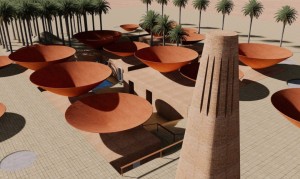
Source: Inhabit
Inhabit is an awesome publication, chock-a-block full of innovations and news. For arid climates comes a new architectural feature, the bowl-shaped roof. More formally called Concave roofs, Iran-based BMDesign Studios addressed its country’s arid climate with an architectural solution. The double-roof system – which features a dome roof topped with a bowl-shaped catchment -collects and stores rainwater and promotes natural cooling.
